Panagiotis D. Diamantoulakis
Deep Learning Optimization of Two-State Pinching Antennas Systems
Jul 08, 2025Abstract:The evolution of wireless communication systems requires flexible, energy-efficient, and cost-effective antenna technologies. Pinching antennas (PAs), which can dynamically control electromagnetic wave propagation through binary activation states, have recently emerged as a promising candidate. In this work, we investigate the problem of optimally selecting a subset of fixed-position PAs to activate in a waveguide, when the aim is to maximize the communication rate at a user terminal. Due to the complex interplay between antenna activation, waveguide-induced phase shifts, and power division, this problem is formulated as a combinatorial fractional 0-1 quadratic program. To efficiently solve this challenging problem, we use neural network architectures of varying complexity to learn activation policies directly from data, leveraging spatial features and signal structure. Furthermore, we incorporate user location uncertainty into our training and evaluation pipeline to simulate realistic deployment conditions. Simulation results demonstrate the effectiveness and robustness of the proposed models.
Fluid Aerial Networks: UAV Rotation for Inter-Cell Interference Mitigation
Jul 02, 2025Abstract:With the rapid development of aerial infrastructure, unmanned aerial vehicles (UAVs) that function as aerial base stations (ABSs) extend terrestrial network services into the sky, enabling on-demand connectivity and enhancing emergency communication capabilities in cellular networks by leveraging the flexibility and mobility of UAVs. In such a UAV-assisted network, this paper investigates position-based beamforming between ABSs and ground users (GUs). To mitigate inter-cell interference, we propose a novel fluid aerial network that leverages ABS rotation to increase multi-cell capacity and overall network efficiency. Specifically, considering the line-of-sight channel model, the spatial beamforming weights are determined by the orientation angles of the GUs. In this direction, we examine the beamforming gain of a two-dimensional multiple-input multiple-output (MIMO) array at various ground positions, revealing that ABS rotation significantly affects multi-user channel correlation and inter-cell interference. Based on these findings, we propose an alternative low-complexity algorithm to design the optimal rotation angle for ABSs, aiming to reduce inter-cell interference and thus maximize the sum rate of multi-cell systems. In simulations, exhaustive search serves as a benchmark to validate the optimization performance of the proposed sequential ABS rotation scheme. Moreover, simulation results demonstrate that, in interference-limited regions, the proposed ABS rotation paradigm can significantly reduce inter-cell interference in terrestrial networks and improve the multi-cell sum rate by approximately 10\% compared to fixed-direction ABSs without rotation.
Cognitive-Radio Functionality: A Novel Configuration for STAR-RIS assisted RSMA Networks
May 30, 2025Abstract:Cognitive radio rate-splitting multiple access (CR-RSMA) has emerged as a promising multiple access framework that can efficiently manage interference and adapt dynamically to heterogeneous quality-of-service (QoS) requirements. To effectively support such demanding access schemes, programmable wireless environments have attracted considerable attention, especially through simultaneously transmitting and reflecting reconfigurable intelligent surfaces (STAR-RISs), which can enable full-space control of signal propagation in asymmetric user deployments. In this paper, we propose the cognitive radio (CR) functionality for STAR-RIS-assisted CR-RSMA systems, leveraging the unique capability of the STAR-RIS to combine element and power splitting for adaptive control of transmission and reflection in CR scenarios. Specifically, the proposed CR functionality partitions the STAR-RIS into two regions independently controlling the transmission and reflection of signals, simultaneously ensuring the required QoS for the primary user and enhancing the performance of the secondary user. To accurately characterize the system performance, we derive analytical expressions for the ergodic rate of the secondary user and the outage rate of the primary user under Nakagami-m fading. Finally, simulation results show that the proposed approach effectively manages interference, guarantees the QoS of the primary user, and significantly improves the throughput of the secondary user, highlighting STAR-RIS as an efficient solution for CR-RSMA-based services.
OFDMA for Pinching Antenna Systems
May 26, 2025Abstract:Pinching-antenna (PA) systems route millimeter wave (mmWave) signals through a leaky waveguide and radiate them at "pinch" apertures, offering low-cost line-of-sight (LoS) coverage. However, when multiple PAs serve multiple users simultaneously, the downlink channel becomes strongly frequency-selective, creating inter-symbol interference (ISI) that existing single-carrier designs overlook. This paper models the overall channel as a finite impulse response (FIR) filter, characterizes its frequency selectivity, and explicitly accounts for the resulting ISI. To overcome ISI, we introduce an orthogonal frequency-division multiple access (OFDMA)-based framework and formulate a max-min resource-allocation problem to achieve user fairness. A lightweight two-stage heuristic-greedy subcarrier assignment, followed by per-user water-filling, achieves near-optimal fairness with polynomial complexity. Simulation results for an indoor layout demonstrate that the proposed scheme notably increases the minimum user rate compared to time-division single-carrier baselines and remains robust under moderate LoS blockage.
Resolving the Double Near-Far Problem via Wireless Powered Pinching-Antenna Networks
May 18, 2025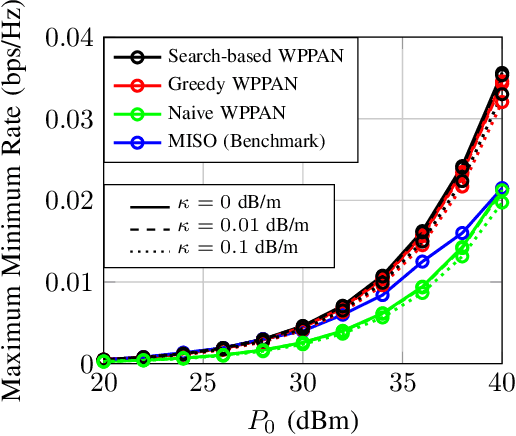
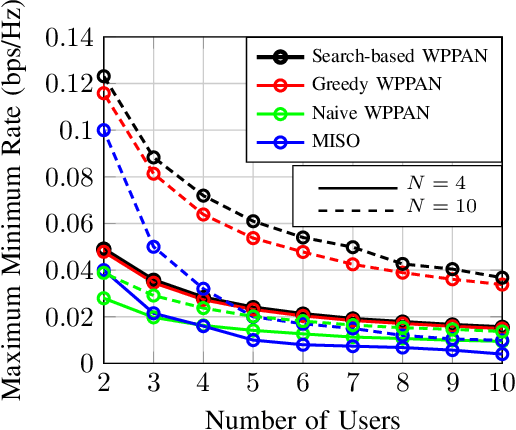
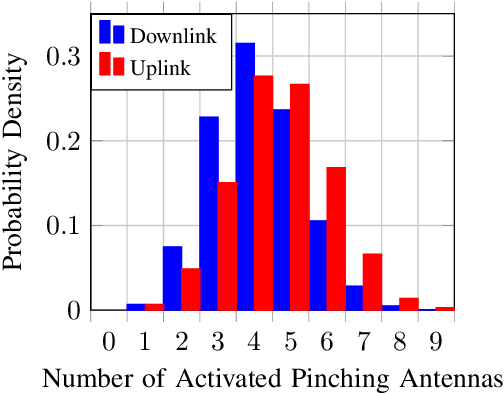
Abstract:This letter introduces a novel wireless powered communication system, referred to as a wireless powered pinching-antenna network (WPPAN), utilizing a single waveguide with pinching antennas to address the double near-far problem inherent in wireless powered networks. In the proposed WPPAN, users harvest energy from spatially distributed pinching antennas in the downlink and use the collected power to transmit messages in the uplink. Furthermore, to manage the combinatorial complexity associated with activating the pinching antennas, we propose three approaches of varying complexity to simplify the original resource allocation problem and then solve it efficiently using convex optimization methods. Simulation results confirm that the proposed WPPAN system effectively mitigates the double near-far problem by providing antenna resources closer to the users, thereby enhancing both downlink energy harvesting and uplink data transmission.
Secrecy Rate Maximization with Artificial Noise for Pinching-Antenna Systems
Apr 14, 2025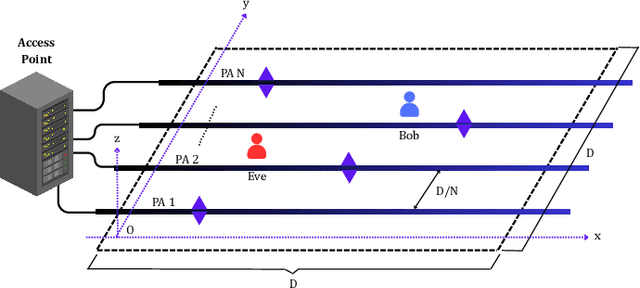
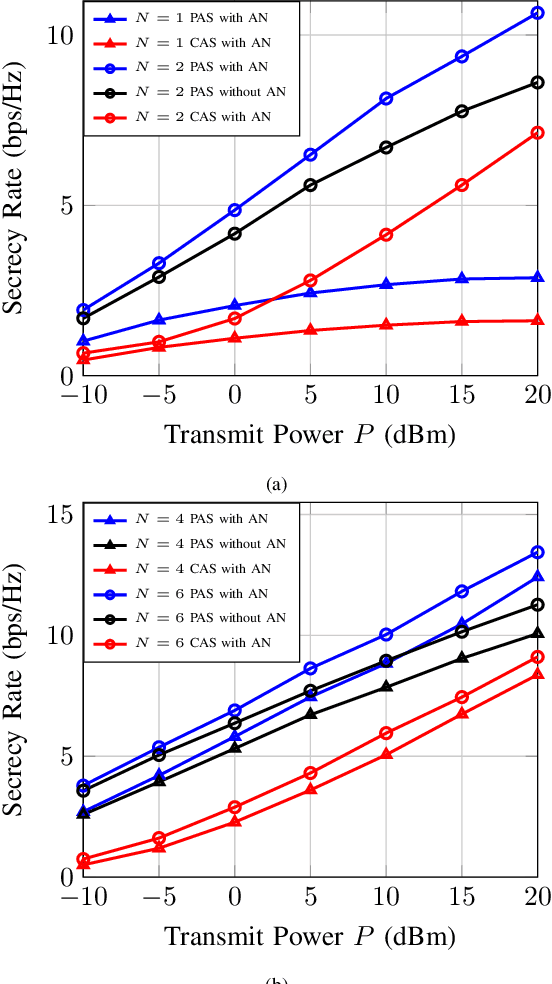
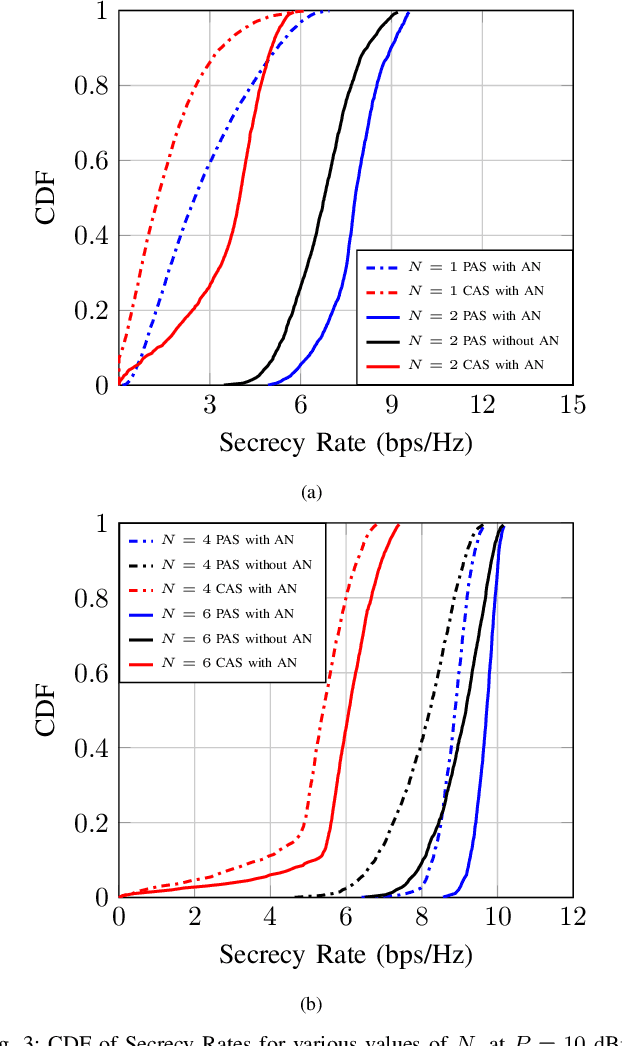
Abstract:Security is emerging as a critical performance metric for next-generation wireless networks, but conventional multiple-input-multiple-output (MIMO) systems often suffer from severe path loss and are vulnerable to nearby eavesdroppers due to their fixed-antenna configurations. Pinching-antenna systems (PAS) offer a promising alternative, leveraging reconfigurable pinching antennas (PAs) positioned along low-loss dielectric waveguides to enhance channel conditions and dynamically mitigate security threats. In this paper, we propose an artificial noise (AN)-based beamforming scheme for downlink transmissions in PAS, with the goal of maximizing the secrecy rate. A closed-form solution is derived for the single-waveguide scenario, while an alternating optimization approach addresses more complex multiple waveguide setups. Numerical results show that the proposed scheme significantly outperforms conventional MIMO and existing PAS security schemes.
Cross-Band Modulation Design for Hybrid RF-Optical Systems
Mar 21, 2025Abstract:We present a novel cross-band modulation framework that combines 3D modulation in the RF domain with intensity modulation and direct detection in the optical domain, the first such integration to enhance communication reliability. By harnessing cross-band diversity, the framework optimizes symbol mapping across RF and optical links, significantly boosting mutual information (MI) and reducing symbol error probability (SEP). Two practical modulation schemes implement this framework, both using quadrature amplitude modulation in the RF subsystem. The first is a linear cross-band mapping scheme, where RF symbols are mapped to optical intensity values via an analytically tractable optimization that ensures O(1) detection complexity while minimizing SEP. The second employs a deep neural network-generated (DNN-Gen) 3D constellation with a custom loss function that adaptively optimizes symbol placement to maximize MI and minimize SEP. Although DNN-Gen incurs higher computational complexity than the linear approach, it adapts the 3D constellation to varying signal-to-noise ratios, yielding significant performance gains. Furthermore, we derive a theoretical MI benchmark for the linear scheme, offering insights into the fundamental limits of RF-optical cross-band communication. Extensive Monte Carlo simulations confirm that both schemes outperform SoA cross-band modulation techniques, including cross-band pulse amplitude modulation, with notable improvements. Additionally, DNN-Gen maintains high performance over a range of RF SNRs, lessening the need for exhaustive training at every operating condition. Overall, these results establish our cross-band modulation framework as a scalable, high-performance solution for next-generation hybrid RF-optical networks, balancing low complexity with optimized symbol mapping to maximize system reliability and efficiency.
Secure Wireless-Powered zeRIS Communications
Mar 10, 2025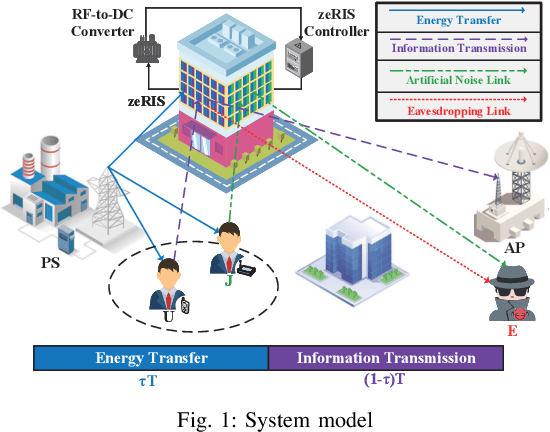
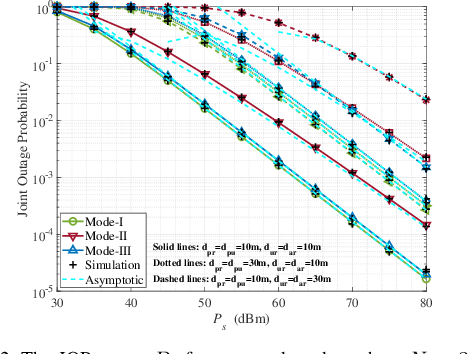
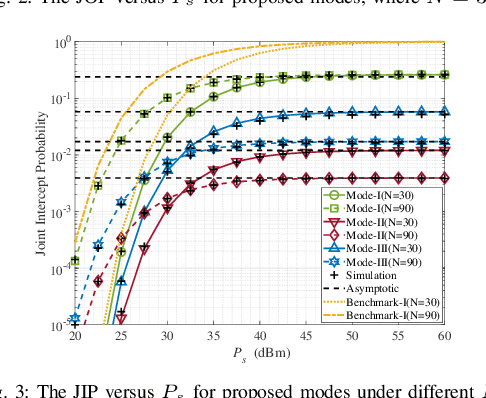
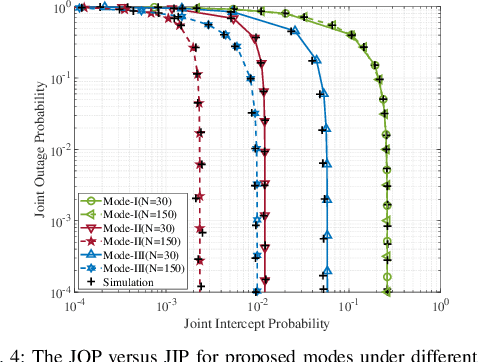
Abstract:This paper introduces the concept of wireless-powered zero-energy reconfigurable intelligent surface (zeRIS), and investigates a wireless-powered zeRIS aided communication system in terms of security, reliability and energy efficiency. In particular, we propose three new wireless-powered zeRIS modes: 1) in mode-I, N reconfigurable reflecting elements are adjusted to the optimal phase shift design of information user to maximize the reliability of the system; 2) in mode-II, N reconfigurable reflecting elements are adjusted to the optimal phase shift design of cooperative jamming user to maximize the security of the system; 3) in mode-III, N1 and N2 (N1+N2=N) reconfigurable reflecting elements are respectively adjusted to the optimal phase shift designs of information user and cooperative jamming user to balance the reliability and security of the system. Then, we propose three new metrics, i.e., joint outage probability (JOP), joint intercept probability (JIP), and secrecy energy efficiency (SEE), and analyze their closed-form expressions in three modes, respectively. The results show that under high transmission power, all the diversity gains of three modes are 1, and the JOPs of mode-I, mode-II and mode-III are improved by increasing the number of zeRIS elements, which are related to N2, N, and N^2_1, respectively. In addition, mode-I achieves the best JOP, while mode-II achieves the best JIP among three modes. We exploit two security-reliability trade-off (SRT) metrics, i.e., JOP versus JIP, and normalized joint intercept and outage probability (JIOP), to reveal the SRT performance of the proposed three modes. It is obtained that mode-II outperforms the other two modes in the JOP versus JIP, while mode-III and mode-II achieve the best performance of normalized JIOP at low and high transmission power, respectively.
Minimum Data Rate Maximization for Uplink Pinching-Antenna Systems
Dec 18, 2024Abstract:This paper addresses, for the first time, the uplink performance optimization of multi-user pinching-antenna systems, recently developed for next-generation wireless networks. By leveraging the unique capabilities of pinching antennas to dynamically configure wireless channels, we focus on maximizing the minimum achievable data rate between devices to achieve a balanced trade-off between throughput and fairness. An effective approach is proposed that separately optimizes the positions of the pinching antennas and the resource allocation. The antenna positioning problem is reformulated into a convex one, while a closed-form solution is provided for the resource allocation. Simulation results demonstrate the superior performance of the investigated system using the proposed algorithm over corresponding counterparts, emphasizing the significant potential of pinching-antenna systems for robust and efficient uplink communication in next-generation wireless networks.
Split Learning in Computer Vision for Semantic Segmentation Delay Minimization
Dec 18, 2024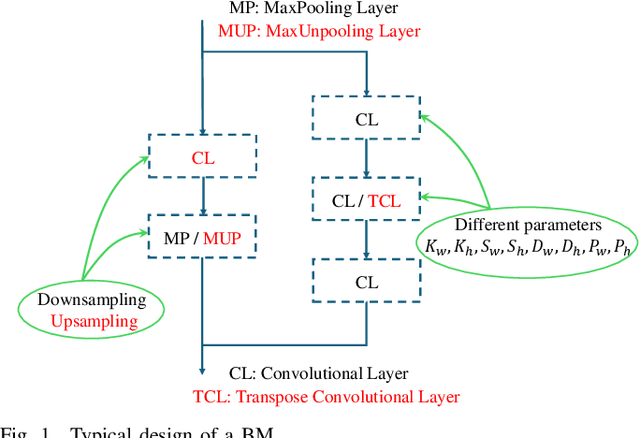
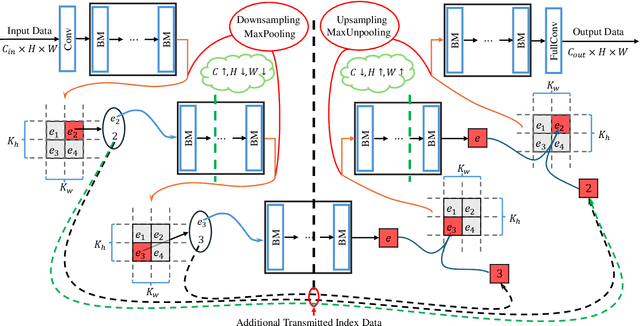
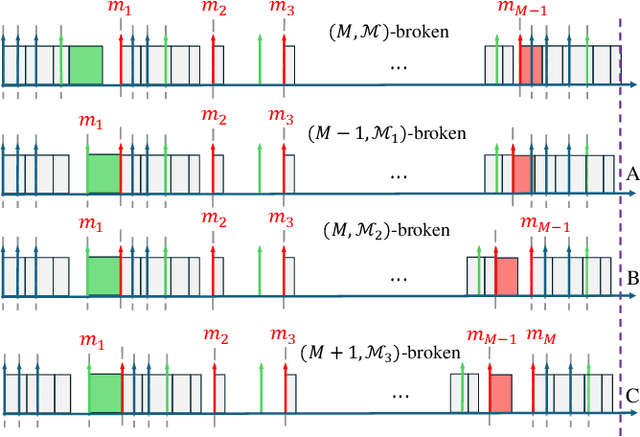
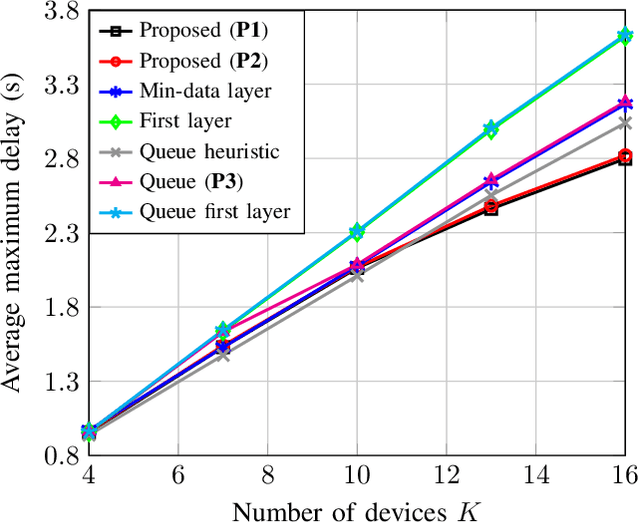
Abstract:In this paper, we propose a novel approach to minimize the inference delay in semantic segmentation using split learning (SL), tailored to the needs of real-time computer vision (CV) applications for resource-constrained devices. Semantic segmentation is essential for applications such as autonomous vehicles and smart city infrastructure, but faces significant latency challenges due to high computational and communication loads. Traditional centralized processing methods are inefficient for such scenarios, often resulting in unacceptable inference delays. SL offers a promising alternative by partitioning deep neural networks (DNNs) between edge devices and a central server, enabling localized data processing and reducing the amount of data required for transmission. Our contribution includes the joint optimization of bandwidth allocation, cut layer selection of the edge devices' DNN, and the central server's processing resource allocation. We investigate both parallel and serial data processing scenarios and propose low-complexity heuristic solutions that maintain near-optimal performance while reducing computational requirements. Numerical results show that our approach effectively reduces inference delay, demonstrating the potential of SL for improving real-time CV applications in dynamic, resource-constrained environments.
 Add to Chrome
Add to Chrome Add to Firefox
Add to Firefox Add to Edge
Add to Edge